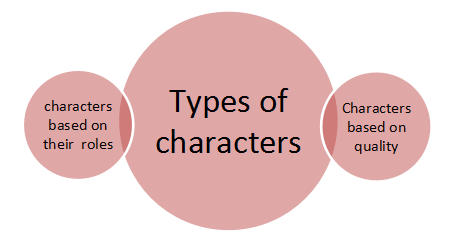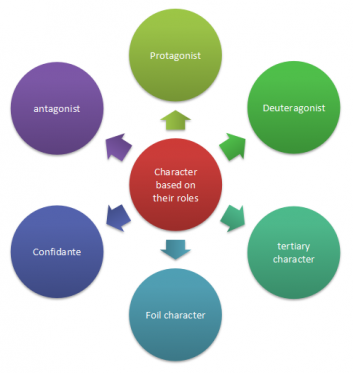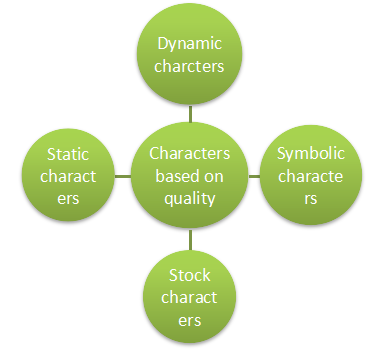Table of Contents
They say it takes diverse kinds of people to make the world go round — and the same principle is applicable to literature as well. As a student, whether you are reading fantasy, drama, comedy or tragedy, you are going to read about different types of characters that keep the story moving and also keep you intrigued.
Now you may already know about the protagonist and antagonist as two distinct types of characters in literature. However, the types of characters in fiction goes well beyond these two categories.
That is why we have presented this elaborate guide on different character types featured in almost every literary work. Before we delve into the types, you must know that there are two main ways to classify them: based on their role, and based on quality.

Characters based on a role refers to the part that one portrays in a work of fiction. In this specific type, the most significant character is the protagonist. This indicates that all other characters are developed according to their relationship to the protagonist. Basically, these types elaborate on how characters interact with each other and influence one another.
This type of character hardly needs any special introduction, as most of us can identify them easily. The protagonist is the star of the story. Most of the action within the story revolves around them. Some popular examples of the protagonist from the world of fiction would be Sherlock Holmes, Hercule Poirot, Robert Langdon, Frodo Baggins, etc.
Every single work of fiction must come with a protagonist. This type of character is vital because other types of characters in a story are defined in relation to the protagonist.
In this case, you must also remember that a work of fiction may not revolve around one single protagonist. There may be more than one protagonist to a story as well. C.S.Lewis’s popular novel series, Chronicles of Narnia, is a great example of a narrative with multiple protagonists. Another popular example would be Enid Blyton’s Famous Five.
In stories narrated in the first-person point of view, the protagonist is usually the narrator, but there are exceptions as well. The narrator can also be someone close to the central character (like Nick Carraway in The Great Gatsby).
This type of character stands in direct contrast with the protagonists. Simply put, this character stands against everything that the protagonist supports. They are as much integral to a story as the protagonists because they have the crucial role of anti-hero to play in the conflicts, that arise within a story. Lord Voldemort, from J.K.Rowling’s iconic Harry Potter series, serves as the finest specimen of an antagonist. As said without a villain, the best heroes wouldn’t have risen. So for any story to get that shine of hero , a proper vitiated antagonist or the Villain character is imperative.
Even though most of the time, the antagonists display evil traits, but there are prominent exceptions in this case.
Various literary pieces have different depictions of antagonists in terms of anatgonist’s
Some literary pieces portray their protagonist as an anti-hero who lacks the typical heroic attributes. William Shakespeare’s Macbeth is a perfect example of an anti-hero. Similarly, some antagonists have been portrayed as morally ambiguous characters, the classic example of which would be Severus Snape from the Harry Potter series.
Another important thing to remember about the antagonists is that they may not always be a person, and can also be a situation or a condition (like depression or anxiety). An example of this would the self-obsession and vanity of Dorian Gray, which ultimately causes his downfall.
Some of the prominent antagonists in English literature are Iago, Professor Jim Moriarty, Mrs. Danvers, Dr Frankenstein etc.
Most literary works have a protagonist and a deuteragonist (or group of deuteragonists). This character is not exactly in the spotlight, but he/she plays a pivotal role in the story.
These characters are often found in the company of the protagonist — giving advice, standing by them when in need, and generally lending a helping hand.
Their presence and close connection with the protagonist give the story warmth and heart. Introducing these characters indicates that it is not just about the protagonist’s journey, however, about the friends, they make along the way. Of course, not all deuteragonist is categorised as friends; some are arch-enemies. But even these less-friendly deuteragonists still add a certain depth to a story.
Moreover certain axioms for charecters to play a proper deuteragonist are
Some prominent examples of deuteragonists are Jane Bennet, Dr. Watson, Mercutio, Samwise Gamgee, Ron and Hermione, etc.
Get your paper written by a professional writer
This type of character is a little tricky to pin down. Since many stories focus so much on the protagonist’s love interest that other relationships get left out in the cold. However, the connection shared between the confidant and the protagonist still has a profound impact on the readers.
Confidants are often closest friends, but they may also be a potential love interest or even a mentor. The protagonists shares their emotions and thoughts with this individual, even the things they’re reluctant to share with anyone else. However, the confidant can also be an individual that the protagonist turns to, not because they want to, but because they believe they have no other option.
Some brilliant examples of confidante would be Horatio, Friar Laurence, Mrs Lovett, Albus Dumbledore, Hannibal Lecter, etc.
These types of characters in the literature appear in and out of a narrative. You may barely find them in one or two scenes from the literary piece.
Having said that, a well-rounded story still needs a few tertiaries to take it forward. In fact, you may find these characters in your day-to-day life as well. Like a baker from your favourite bakery, or the random guy you sit next to in a bus.
Some specimen of the tertiary characters in literature are Madame Stahl in Anna Karenina, Radagast in The Lord of the Rings, Parvati and Padma Patil in Harry Potter, Fabrizio and Calo in The Godfather, etc.
A foil character is someone whose values and personality essentially clash with the protagonist’s. This clash demonstrates the central character’s defining attributes, offering the readers a clear idea of who they truly are.
The foil’s exact relationship to the protagonist relies on the differences between them. For instance, if the protagonist is introverted, their foil might be super extroverted, but that wouldn’t necessarily lead the two of them to become friends. However, if the central character is kind and their foil tends to be self-serving, they’re probably not going to get along.
Lydia Bennet, Draco Malfoy, Paris, Circe, are some of the famous examples of foil characters in literature.

Character quality denotes what kind of character someone is. This doesn’t indicate their temperament, like being helpful or mean, but instead their nature within the story, like being dynamic or static.
These types happen to focus on narrative purpose in a story. For instance, a dynamic figure presents a compelling arc for readers to follow, and a symbolic one represents some underlying moral or theme.
This one’s quite self-explanatory. A dynamic character is one who evolves over the course of a narrative. They often evolve to become better or wiser. The character may change positively and negatively depending on the need of the story.
Some of the most common examples of dynamic characters are Don Quixote, Elizabeth Bennet, Neville Longbottom, Han Solo, and Walter White.
This types of characters are the exact opposite to their dynamic counterparts. These static figures often tend to be unlikable, like Cinderella’s stepsisters or the Dursleys from Harry Potter— their ignorance or mistreatment towards the protagonist makes them people that the readers “love to hate,” and amplifies sympathy for the protagonist.
Some other valid examples of static characters are Miss Havisham, Mr Collins, Sherlock Holmes (a rare static protagonist), etc.
A symbolic character is incorporated to represent something more important than themselves. This type of character must also be utilised sparingly, or at least subtly, so the reader doesn’t feel like the symbolism is too heavy. As an outcome, the true nature of a symbolic character may only be fully realised at the very end of a story.
Some pertinent examples of symbolic characters are Aslan (symbolises God/Jesus in The Chronicles of Narnia), Gregor Samsa (symbolises the difficulty of change/being different in The Metamorphosis), Jonas (symbolises hope in The Giver), etc.
Stock characters are those familiar figures that feature in the stories time and again. Even though it’s best not to overuse them, but they can really help make readers feel “at home” in your story.
The idea is to not just rely on their archetypal features. Take Albus Dumbledore, for example. He might seem like a “stock” mentor in his appearance and sage manner. However, his wisecracks and weaknesses highlighted later in the series reveal that he’s a fully-fledged character in his own right.

Wrapping it up,
Not every literary work will include every type of character. But the more learn about the different character types, the easier it will be to evaluate them while working on an academic task.
While working on a literature assignment, you may have trouble analysing the characters within a literary piece of work. But that doesn’t mean you should spend sleepless nights trying to put together the task. This is when you should approach the experts on MyAssignmenthelp.
Whether it’s foil literary definition or flat character definition, our experts will evaluate the character in most appropriate way possible. They are perfectly aware of each of the different types of characters that exist in the realm of literature.
When you opt for our services, you not only receive impeccably written academic papers but also enjoy the various incredible features on our site. Some of these features include-
You won’t have to look elsewhere for support when you avail the assistance of our website. So, place an order now!